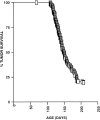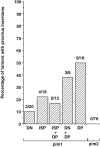PIM1 reconstitutes thymus cellularity in interleukin 7- and common gamma chain-mutant mice and permits thymocyte maturation in Rag- but not CD3gamma-deficient mice
- PMID: 10523604
- PMCID: PMC2195657
- DOI: 10.1084/jem.190.8.1059
PIM1 reconstitutes thymus cellularity in interleukin 7- and common gamma chain-mutant mice and permits thymocyte maturation in Rag- but not CD3gamma-deficient mice
Abstract
The majority of lymphomas induced in Rag-deficient mice by Moloney murine leukemia virus (MoMuLV) infection express the CD4 and/or CD8 markers, indicating that proviral insertions cause activation of genes affecting the development from CD4(-)8(-) pro-T cells into CD4(+)8(+) pre-T cells. Similar to MoMuLV wild-type tumors, 50% of CD4(+)8(+) Rag-deficient tumors carry a provirus near the Pim1 protooncogene. To study the function of PIM proteins in T cell development in a more controlled setting, a Pim1 transgene was crossed into mice deficient in either cytokine or T cell receptor (TCR) signal transduction pathways. Pim1 reconstitutes thymic cellularity in interleukin (IL)-7- and common gamma chain-deficient mice. In Pim1-transgenic Rag-deficient mice but notably not in CD3gamma-deficient mice, we observed slow expansion of the CD4(+)8(+) thymic compartment to almost normal size. Based on these results, we propose that PIM1 functions as an efficient effector of the IL-7 pathway, thereby enabling Rag-deficient pro-T cells to bypass the pre-TCR-controlled checkpoint in T cell development.
Figures








Similar articles
-
Runx2: a novel oncogenic effector revealed by in vivo complementation and retroviral tagging.Oncogene. 2001 Jan 18;20(3):295-302. doi: 10.1038/sj.onc.1204090. Oncogene. 2001. PMID: 11313958
-
Contributions of the T cell receptor-associated CD3gamma-ITAM to thymocyte selection.J Exp Med. 2002 Jul 1;196(1):1-13. doi: 10.1084/jem.20020268. J Exp Med. 2002. PMID: 12093866 Free PMC article.
-
Transgenic expression of the p16(INK4a) cyclin-dependent kinase inhibitor leads to enhanced apoptosis and differentiation arrest of CD4-CD8- immature thymocytes.J Immunol. 2002 Mar 1;168(5):2325-31. doi: 10.4049/jimmunol.168.5.2325. J Immunol. 2002. PMID: 11859122
-
Fidelity and infidelity in commitment to B-lymphocyte lineage development.Immunol Rev. 2000 Jun;175:104-11. Immunol Rev. 2000. PMID: 10933595 Review.
-
Monoclonal antibodies to the common gamma-chain as cytokine receptor antagonists in vivo: effect on intrathymic and intestinal intraepithelial T lymphocyte development.J Leukoc Biol. 1998 Jun;63(6):643-9. doi: 10.1002/jlb.63.6.643. J Leukoc Biol. 1998. PMID: 9620654 Review.
Cited by
-
A small molecule inhibitor of Pim protein kinases blocks the growth of precursor T-cell lymphoblastic leukemia/lymphoma.Blood. 2010 Jan 28;115(4):824-33. doi: 10.1182/blood-2009-07-233445. Epub 2009 Nov 23. Blood. 2010. PMID: 19965690 Free PMC article.
-
c-Myb regulates the proliferation of immature thymocytes following beta-selection.EMBO J. 2000 Nov 15;19(22):6112-20. doi: 10.1093/emboj/19.22.6112. EMBO J. 2000. PMID: 11080157 Free PMC article.
-
αβ versus γδ fate choice: counting the T-cell lineages at the branch point.Immunol Rev. 2010 Nov;238(1):169-81. doi: 10.1111/j.1600-065X.2010.00947.x. Immunol Rev. 2010. PMID: 20969592 Free PMC article. Review.
-
c-Myc mediates pre-TCR-induced proliferation but not developmental progression.Blood. 2006 Oct 15;108(8):2669-77. doi: 10.1182/blood-2006-02-005900. Epub 2006 Jun 20. Blood. 2006. PMID: 16788099 Free PMC article.
-
Summary of presentations at the NIH/NIAID New Humanized Rodent Models 2007 Workshop.AIDS Res Ther. 2008 Jan 31;5:3. doi: 10.1186/1742-6405-5-3. AIDS Res Ther. 2008. PMID: 18237418 Free PMC article.
References
-
- Rodewald H.R., Fehling H.J. Molecular and cellular events in early thymocyte development. Adv. Immunol. 1998;69:1–112. - PubMed
-
- Fehling H.J., von Boehmer H. Early alpha beta T cell development in the thymus of normal and genetically manipulated mice. Curr. Opin. Immunol. 1997;9:263–275. - PubMed
-
- Leonard W.J., Shores E.W., Love P.E. Role of the cytokine receptor γ chain in cytokine signaling and lymphoid development. Immunol. Rev. 1995;148:97–114. - PubMed
-
- Sugamura K., Asao H., Kondo M., Tanaka N., Ishii N., Nakamura M., Takeshita T. The common gamma-chain for multiple cytokine receptors. Adv. Immunol. 1995;59:225–277. - PubMed
-
- Cao X., Shores E.W., Hu-Li J., Anver M.R., Kelsall B.L., Russell S.M., Drago J., Noguchi M., Grinberg A., Bloom E.T. Defective lymphoid development in mice lacking expression of the common cytokine receptor gamma chain. Immunity. 1995;2:223–238. - PubMed
Publication types
MeSH terms
Substances
LinkOut - more resources
Full Text Sources
Other Literature Sources
Molecular Biology Databases
Research Materials
Miscellaneous

